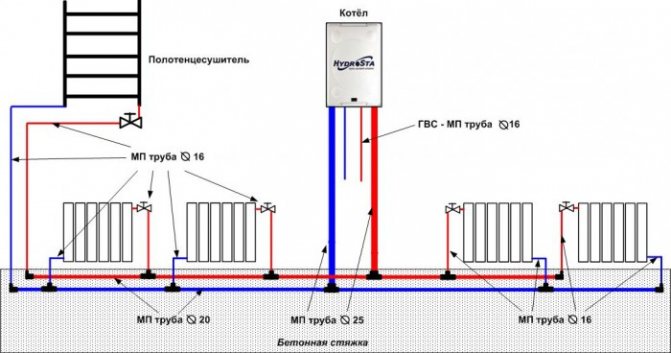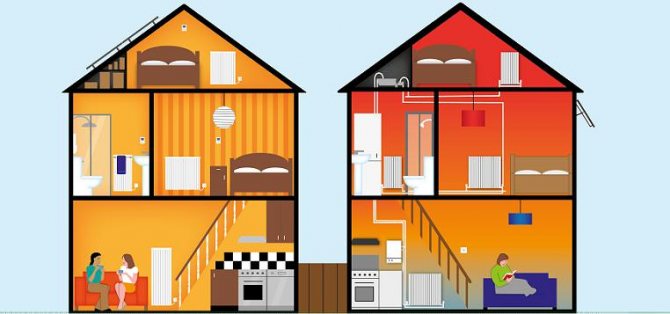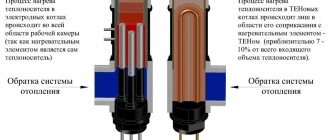Pros and cons
Dignity
Let's take a closer look at the second option and define its positive and negative aspects. To begin with, let's figure out what an autonomous heating point is. This is a separate room where boiler equipment is located, the power of which is sufficient to provide heat and hot water to the entire apartment building. This is a kind of mini-boiler room with a full range of necessary devices, fixtures and systems. Modern technologies for providing heat to residential buildings began to be used precisely in autonomous systems. The latter worked for one or more houses, which was doubly profitable. Why?
- Firstly, the distance from the heat generator to the heating devices in each apartment has been significantly reduced. This means that the heat loss has decreased due to the transportation of the coolant.
- Secondly, the time for supplying heat to the consumer has decreased, which, again, is associated with a decrease in distance.
- Thirdly, the costs of maintenance of heating networks, their repair and installation have changed to a lesser extent.
- Fourth, the economic performance resulting from the previous benefits has declined. This means that the cost of the supplied coolant has changed to a minimum.
Autonomous system diagram
There is one more advantage of the system. When a house is being built, the developer is required to obtain a large number of permits that will allow him to crash into the central highway. The bureaucratic delays sometimes take more than one month. And the installation of a metering device will cause a lot of disputes between developers and the host, that is, the operating company. So for builders, option c, even for the largest house, is ideal.
And the last advantage - the boiler house for the microdistrict occupies a place where not only buildings and water tanks will be erected, but also an electrical substation, access roads, warehouses, office premises, administrative buildings, etc. That is, a fairly impressive site will have to be allocated for it. And if there is no need for a boiler room, the district administration can use this area for its own needs. For example, to build another residential building, school, clinic, etc.
disadvantages
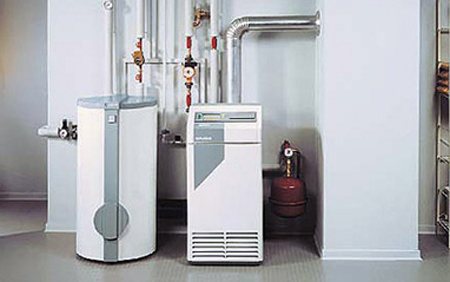
Gas boilers
Cons exist in any system, but there are usually fewer of them:
- An autonomous boiler room should be located in a separate building, therefore, it is necessary to allocate a site for it near the house. Sometimes such a building looks like an extension.
- Mini-boilers pollute the environment to a certain extent. Therefore, modern cleaning devices are indispensable here. And being inside micro-districts obliges to create conditions for environmentally friendly performance indicators. They exist and are stipulated by the norms and rules of SNiP. Hence the rise in the cost of the equipment itself.
- An autonomous heating system is not yet as popular as a centralized one, therefore the production of equipment and related components has not yet been put on stream. Hence the high cost of such systems. This means that not all developers can afford them.
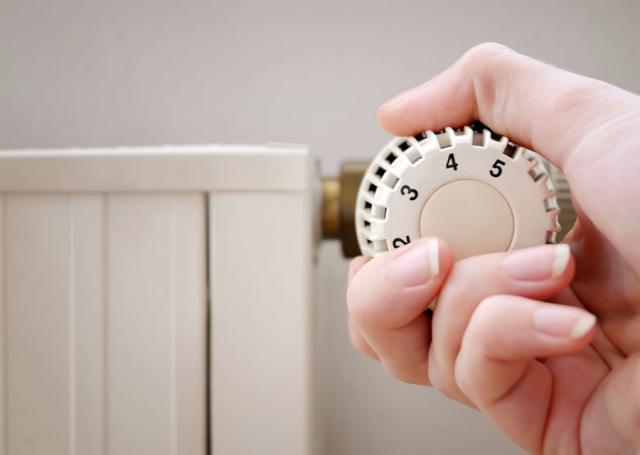

Heating regulator
However, experts say that engineering developments today make it possible to eliminate some of the shortcomings. For example, if an autonomous boiler room is used to heat only one apartment building, its equipment can be placed in the attic - the dimensions of the devices allow this. In addition, the attic immediately becomes heated, which is undoubtedly a plus. In addition, the area between the houses is freed up.The only requirement for such options is a flat roof, which is not a problem. If you plan to install just such a heating system, then you can add a flat roof to the project. Experts have already carried out preliminary calculations, which have shown that even if the cost of equipment and installation costs are high, all this will pay off in several seasons.
Single or double-circuit gas boilers?
Already by the name, one can partially determine the answer to the question of how one- and two-circuit models differ from each other. In the first case, only water is heated for the heating system, in the second - also for hot water supply. The double-circuit gas boiler is distinguished by its design by the presence of an additional heat exchanger. In this case, the direction in which the coolant moves is regulated by a special valve. Moreover, DHW is always a priority.
- Low cost compared to dual-circuit models.
- Higher power (only models with one circuit can be made in a floor-standing version, respectively, they can be equipped with a cast-iron heat exchanger, which is more efficient).
- The choice of equipment for heating a large building.
- Reduced fuel consumption.
- To provide the house with hot water, you will need to purchase additional equipment, which will require appropriate investments, allocation of space for installation.
- The complex of heating and hot water equipment takes up a lot of space and requires a large number of communications to be connected, which may look unaesthetic in the house, therefore, most often, if there is such an opportunity, a separate room is allocated for the boiler room.
- Compact dimensions of the equipment.
- Simplicity of operation, maintenance (it is easier and cheaper to maintain one piece of equipment than two).
- For installation, you can painlessly use the utility room without allocating a separate room for this purpose.
- The relatively high cost of the equipment itself, its installation and maintenance.
- Unstable coolant temperature and water pressure (especially if 2 draw-off points are used simultaneously).
We offer you to familiarize yourself with: Ppr for screed with cement-sand mortar
Paperwork and its difficulties
If usually the sum of money for the service acts as a catalyst for all problems, then in the case of autonomous heating it is the collection of all the necessary confirmations and permits for installation.
In addition, permits may not be obtained at all, since officials are very reluctant to meet halfway and may simply stall the issue, especially if the apartment in the house is the only one claiming heating independence. If a refusal occurs, then it is imperative to convene a commission, which, with the support of independent experts, will have to justify the decision of the utilities and make a final verdict.
On the other hand, if the house is not an apartment building, but its own, then the problems become much less. This is due to the fact that you can simply contact the installation company, which will deal with all problems: from obtaining the necessary documents to installing the boiler.
Gas roof boiler room
The device has the following positive aspects:
- High efficiency. Fuel consumption is reduced by using LPG, which releases energy when heated.
- There are almost no external communications. This reduces the cost of funds. Heat loss is also reduced.
- In low-rise buildings (up to 26 m), there are no additional installation requirements, which reduces the cost of the project.
- Automation, which reduces the cost of operation.
- The appliance is not shut down for annual inspection, which allows daily use of hot water.
The device has several limitations.To accommodate the boiler room, the roof is strengthened by installing a concrete cushion. The load that the building can withstand is calculated in advance.
For installation, they bring special equipment, the work of which creates inconvenience to the residents. The cost is also unpleasant: the costs go to the creation of the project, the laying of the gas carrier, the automation responsible for the control. Additionally, protective measures and a fire extinguishing system are installed.
Benefits of Autonomous Systems
Autonomous heat supply of an apartment building has many advantages to its owners:
- The heat supply of an apartment building is almost completely automated, therefore you can set a certain temperature mode and it will be observed by the device. In addition, it will be possible to set the minimum temperature parameters in case of departure, so that excess heat will not go into the void.
- Autonomy allows you to depend only on yourself, because constant pipe breaks from utility companies will no longer turn off the heating. While many will wait for the return of heating, the owner of the autonomous heating in the apartment can calmly bask in his apartment.
- The devices undergo a technical check, therefore breakdowns are extremely rare and you can fully rely on the heating system and not be afraid of turning off the heat supply at the most inopportune moment.
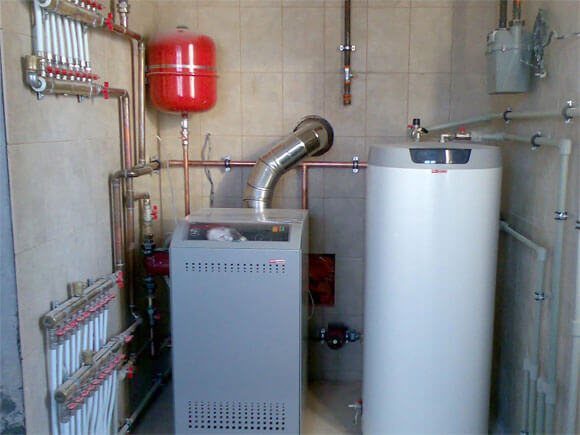

Electric heating systems
Today, electrical equipment for decentralized heating is considered the most economical. In the operation of such devices, as a rule, the principle of water polarization under the influence of alternating current is used.
Connecting one apartment assumes a simple autonomous system with the installation of an electric boiler with an anode principle of operation. The use of double-circuit systems implies the possibility of arranging underfloor heating through a separate circuit. For small-sized rooms, the best option would be special batteries with individual heating, which allow you to independently regulate the heat indicators.
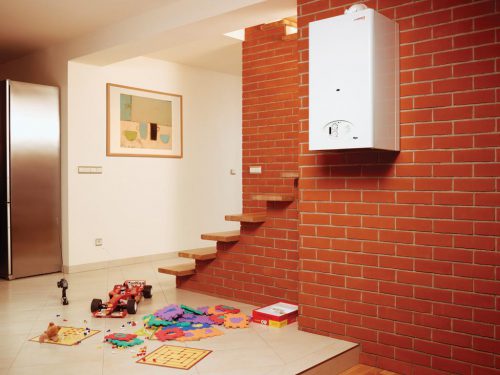

A more complex process is the transfer of an entire residential building to an autonomous electrical system. To do this, initially it is necessary to resolve issues with the substation, calculate the expected load on the power grid in accordance with the power of the transformer. Switchgears should be replaced if necessary. This event must be coordinated with the energy company.
Important! Most older systems and wiring will not be able to handle high loads. Therefore, in a house converted to autonomous heating, it is recommended to replace incandescent lamps with LED sources, as well as to reduce other electricity costs.
Wall and floor gas boilers
The differences between the models in the way they are installed are determined primarily by their power. For small country houses or apartments with individual heating, a wall-mounted boiler and its performance are quite enough. At the same time, a powerful unit with a cast-iron heat exchanger can only be in a floor-standing version.
- Compact size and light weight.
- Relatively low price.
- Neat installation that can be successfully implemented in a residential building.
- Multifunctionality.
- Wide range of models.
- Possibility of choosing a two-circuit model.
disadvantages
- Volatility (in the event of a power outage, the automation completely turns off the boiler). A way out of the situation for areas with frequent problems in the power supply can be the purchase of an uninterruptible power supply.
- Relatively low heat output.
- Difficulty in maintenance and repair.
- When used in the structure of a heat exchanger made of cast iron, the service life of a floor-standing gas boiler can exceed 30 years.
- Easy to maintain and repair design.
- High reliability.
- Energy independence.
- The possibility of heating a large area.
- Comparatively large dimensions.
- Difficulties in installing equipment in a residential building.
Gas heating
As a rule, apartment owners have a choice between two types of alternative heat sources:
- Structures based on a gas boiler.
- Electrical heating systems.
Gas heating has several advantages:
- Modern boilers are equipped with an enhanced security system and operate autonomously. maintaining the level of heat that the residents need.
- Such boilers are small in size. therefore they can be installed even in small rooms.
- It is easy to install, so even a beginner can do it with the proper care and some tools and skills.
- Autonomous gas heating in the apartment is equipped with a chimney system and does not have to be carried out separately.
- Gas boilers operate absolutely silently. so do not cause complaints from neighbors.
- Affordable price and complete completeness of all units and parts make gas heating the most frequent choice among consumers.
When installing a new heating system, the old system must be dismantled. It is easier and cheaper to install new radiators than trying to fit old ones. Although modern gas boilers have the highest degree of protection, gas leaks are still possible.
Useful features of an automated autonomous system
Almost every autonomous heating system is equipped with a number of functions that greatly simplify the life of its owners:
- Automated systems can distinguish between sudden changes in temperature outside, adjusting the indoor climate of the room as needed. Thanks to this, even in the absence of the owners of the dwelling, the temperature will not drop, and the boiler will start heating the water on time.
- If the outside temperature rises, the system will reduce energy consumption while maintaining the same room temperature.
- Automatic systems can reduce performance during the day and night, but at the same time they pump up heat in the evening and in the morning when it is especially necessary. Thanks to this, a pleasant temperature regime in the room is created, and fuel is not consumed unnecessarily.
- The system can be equipped with a room temperature sensor. For this, it is installed in rooms that are not combined with the boiler room. If there is a change in temperature, the heating system starts up and regulates the temperature in the desired direction.
The presence of negative sides
There are many advantages, but there is always a negative side. The very first thing, apartment heating boilers require the removal of combustion products - smoke. From every square meter, the owner should not throw smoke into the street. This is strictly prohibited. Therefore, it will be necessary to create a single chimney. If you calculate the cost of it, it will turn out to be expensive. In addition, it will have to be built according to all the rules, and this will take a lot of time.
Such a house with apartment heating would be considered dangerous. Because on the area of each apartment there will be a gas boiler, and this substance is considered explosive. But when every person approaches the issue of installation with all seriousness and chooses a high-quality boiler, this minus is skipped.
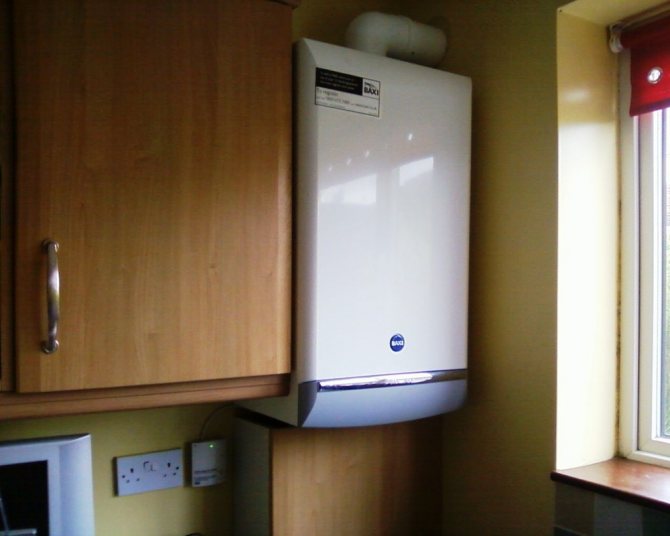

Selection of fuel and boiler
For an automatic heating system, gas is most often used, as it is one of the cheapest natural resources. In addition, many boilers are designed specifically for it and can be placed both on the floor and on the wall.
As for the boiler itself, the key choice here is between cast iron or steel equipment.
Steel boilers are prone to corrosion, and therefore not as durable as cast iron models.On the other hand, it is much easier to mount a steel unit than a cast iron unit due to the weight of the unit. In addition, it is much easier to hang a steel boiler on the wall, which is why most of these models are made from this material.
How to calculate the cost of autonomous heating, see the example in the video:
Disconnection procedure from the centralized heating system
Preparing all the necessary documents for the transition to individual heating of housing, it is necessary to study the relevant legislation:
- Federal Law No. 190 of July 27, 2010;
- Resolution of the Government of the Russian Federation No. 307 of April 16, 2012;
- Art. 25, 26 of the Housing Code of the Russian Federation.
The easiest solution is to install an electric boiler. You just need to draw up a statement and transfer it to the district power grid. With appropriate technical conditions, the permit will be issued quickly. But the heat generated in this case can exceed the cost of heat energy from centralized heating.
Therefore, the installation of a gas boiler is more profitable in terms of cost savings, since the cost of natural gas is relatively low. But when carrying out individual gas heating, you will have to follow many formalities:
In the city gas service, it is necessary to obtain the appropriate technical conditions. Check the chimney for serviceability and get an opinion on this from the All-Russian Voluntary Fire Society (VDPO). Obtain the consent of the rest of the residents of the house (this paragraph is spelled out in part 3 of article 36 of the Housing Code of the Russian Federation)
This is very important, because in the event of a refusal of one apartment from centralized heating, malfunctions of the entire system may appear. In addition, it is necessary to raise the relevant documents and find out who owns such system elements as batteries and piping.
If they are in common house ownership, you must also issue a special permit from the neighbors. If the heating components are not common property, a disconnection permit must be obtained from the management company. In city heating networks, get the right to dismantle the heating system in your apartment.
For those residents who have gas water heaters installed in their apartments, it will be easier to obtain a permit for individual heating, since such buildings have a chimney, and the pressure in the gas pipeline is suitable for the functioning of a gas boiler.
Having received preliminary permission for a gas heating project, the following documents should be prepared:
- A statement in which you need to indicate that the owner of the apartment plans to make individual heating and disconnect from the centralized system.
- The original technical passport of the apartment, which should indicate the location of the batteries and pipes.
- Permission from the residents of the building (if the components of the system are common property) or from the management company.
- Decision on a possible redevelopment of the apartment. It is issued by the ZhEK or the management company.
The term for obtaining permission to dismantle a centralized system and equip an individual one can last from 3 months to six months. After obtaining permission from the representatives of the utilities, you can proceed to dismantle the heating elements in the apartment.
Benefits for the developer
It is the companies that build houses that have received benefits that have become less costly for them:
- There is no need to lay expensive heating lines and create heating points.
- The device of metering devices is not performed.
- Houses are being built in all areas of the city where there is an uninterrupted gas supply.
Companies that carry out maintenance in such construction also received their advantages:
- Easy to maintain gas boilers. This is a big plus for the respective organizations.
- There is no need to disrupt the operation of the heating system in each apartment when replacing pipes during the repair or redevelopment of the premises. Everyone leads an individual approach and maintenance of their devices.
- Payment is made according to individual counters, which is easier to control. The debt is working with only one user, and not with all the tenants of the apartment building. It is very convenient.
In addition, the executive authorities also benefit. There are positive aspects for them. This includes:
- There is no need to build a central heating main, which means that the money remains in the budget.
- No need to ask for subsidies.
- There is no need to look for heat losses and reimburse costs in heating networks.
- All responsibility lies with the owners of the apartment, in terms of fees and maintenance.
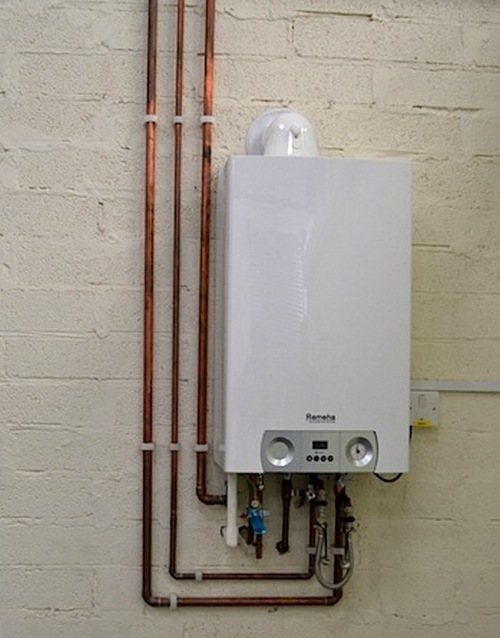

Selection of pipes, boiler and radiators
The operation of the entire system depends on the correct choice of the boiler.
For example, if the installation of a boiler is required for heating water, then you can get by with the option of a single-circuit gas boiler.
When making a choice in favor of gas heating, it is better to purchase a boiler made of cast iron or special durable metal. Although heavy, they will last much longer.
But pipes for such a heating system are suitable for polypropylene or metal-plastic. as a budget option, and copper, if the wallet allows it.
Radiators will also have to be determined in advance. Today, bimetallic heating radiators are very popular among consumers.
Which ones are actually better for an apartment can be determined by the amount of their heat transfer, for example:
Before buying radiators, you need to calculate in advance how many sections are required for each room. To do this, the heat transfer of the material must be divided by 100. For example, for a bimetallic radiator, it is 199 W / 100, which equals 1.99 W per 1m2.
There are several nuances that should be considered when choosing radiators and calculating their number:
- If the installation of batteries is supposed to be in a corner room, then 2-3 sections must be added to the results that were obtained during the calculations.
- When decorative panels are installed that hide the batteries behind them, the heat transfer is reduced by 15%, which should be taken into account before calculations.
- Insulated walls or plastic windows can reduce heat loss.
- Installing a meter will allow you to independently regulate gas consumption.
Having made all the calculations and adding to them the cost of the most autonomous gas heating system, you can make a decision about buying it, or you can compare these figures with electric types of heating.
Classification of gas boilers
| Gas boilers | Number of contours | Single-circuit |
| Double-circuit | ||
| Ignition type | Electronic | |
| Piezo ignition | ||
| Installation method | Wall mounted | |
| Floor standing | ||
| By the way of traction | Ventilation | |
| Natural | ||
| Power modulation | Single stage | |
| Two-stage |
Installation
To create a heating system on the roof, you need to build a separate room. The roof-top boiler house is autonomous: having started it, it is enough to carry out rare scheduled inspections.
The process depends on the device variant. There are 2 types - built-in and block-modular.
Built in
Boiler rooms built into the roof are used in new buildings. Such a device is installed only in a building under construction or a building that has a place for a thermal station. For built-in boiler rooms, they must calculate the additional load on the walls of a multi-storey building, create a fire extinguishing module.
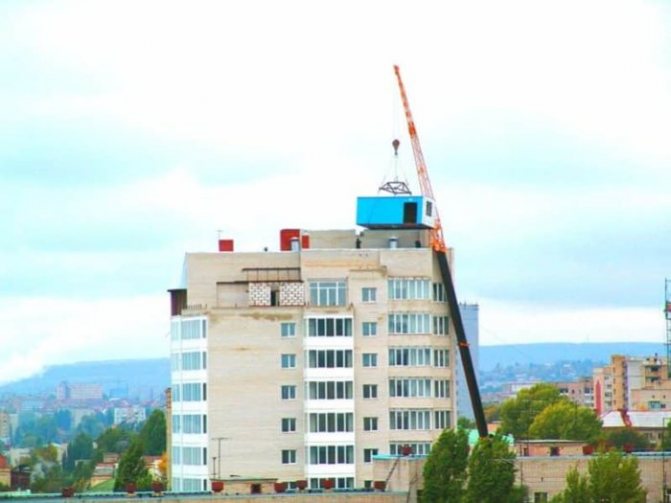

The main advantage of the device is the ease of creating and implementing a project. Along with the installation, work is being carried out to install sound-absorbing coatings and vibration protection. Carried out at the stage of finishing, they are more efficient in operation.
Block-modular
A block-modular type is used to accommodate a roof-top boiler room in the constructed building. The most common installation option is during a major overhaul. The roof boiler room is installed in case of restoration of the heating system. The project is created based on the characteristics of the building. Then the device is created and delivered to the required structure.
Before installation, a roof audit is carried out:
- Check the condition of the bearing supports.
- Apply a protective coating to the installation point. A concrete pillow acts as them.
- Installation of sound-absorbing material is carried out.
After completing the preparation, the boiler room is connected to the heating network. It is adjusted, the coolant is distributed. Having connected to the heating, they begin to operate.
What to look for
Before installing the device, you must take into account that it creates a load on the structure. Because of this, the following rules are required:
- It is forbidden to place the boiler room on the ceiling above the living quarters.
- It is forbidden to place the equipment in a room adjacent to a residential one.
- When designing, the size of the house in which the placement is planned is observed.
- When designing, an emergency shutdown system is created.
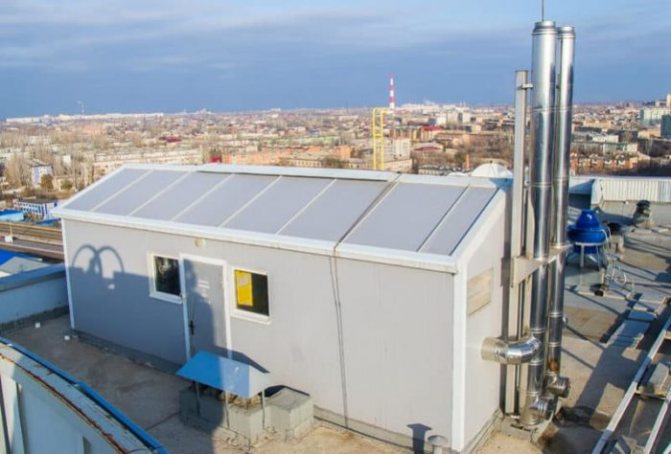

What are the differences between individual heating with a gas convector?
The main feature of a gas convector is that it dispenses with an intermediate heat carrier and immediately heats the air in the room through heat exchangers. The combustion products are discharged into the pipe through a through hole in the wall. The system is designed in such a way that the room is automatically saturated with fresh air for combustion and uninterrupted operation of the device.
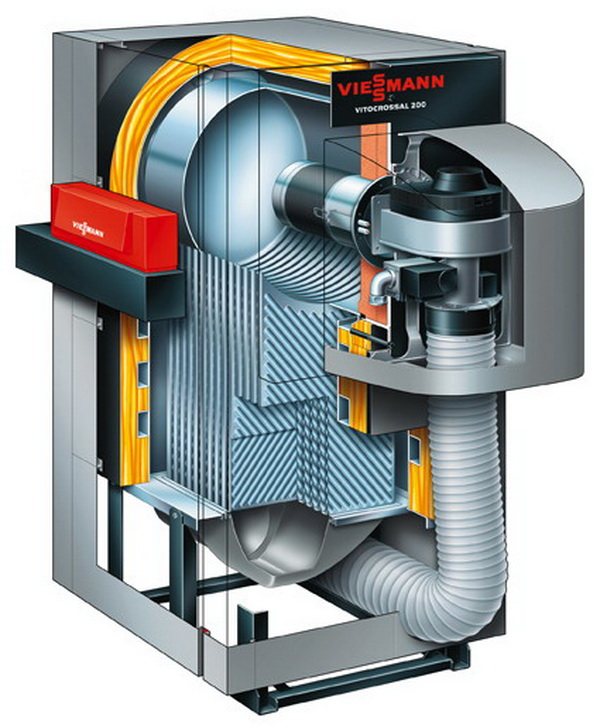

Gas convector device
Distinctive features during the operation of convectors:
- There is no need for installation in the organization of pipes inside a private house and a separate boiler room.
- It becomes necessary to install a separate convector in an isolated room, which is associated with the difficulties of forming a gas distribution in all rooms or installing a separate cylinder in them.
- A significant drawback is the uneven distribution of heat in the room: there is a high temperature at the top of the ceiling, and the floor is cold.
- Ease of installation and start-up of gas convectors.
This option is relevant if it is impossible to connect to the main gas pipeline system.
Benefits
In order for the roof boiler room of a residential building to work stably, it is necessary to carry out careful calculations and not save on installation. Equipped on the roof of the house, it has advantages over other systems:
- Installed on the roof of the house, the boiler room reduces energy losses during the transfer of coolant from the rooftop equipment to the radiators. This reduces the cost of heating services by up to 30%.
- Automation serves the use of hot water during the absence, when the supply is turned off to check the media.
- Maintenance of the device is reduced due to autonomy. Functional check is carried out rarely, by agreement with the service company.
- Before operation, many checks are carried out to detect malfunctions and safety errors.
Varieties of decentralized heat supply
Of course, building a stand-alone boiler room, even a small one, is quite expensive. And the attic option is also not cheap. However, there is an alternative.
Modular boiler rooms
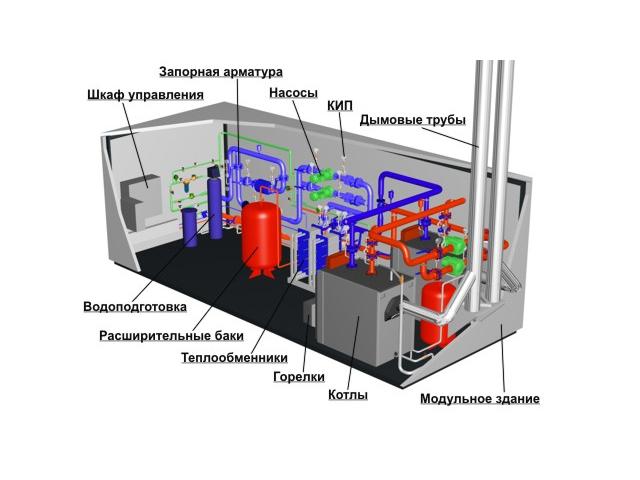

Block-modular boiler room
One of the very interesting projects is modular, or block, boiler rooms. There is no need to build anything, and only a small site is allocated for the boiler room. Blocks are brought here, which are easily and quickly combined into a finished structure.
All of them are completed at the factory, the equipment inside them is precisely matched to technical indicators, they are insulated and have a presentable appearance. The most important thing is to properly arrange and connect the equipment. A couple of days and the boiler room is ready
But only specialists should be engaged in its assembly.If anyone remembers, such modular boiler rooms were used to heat change houses and barracks, that is, temporary structures. After engineers and designers worked on them, such autonomous installations began to be used for organizing heating in apartment buildings. However, this option is not the only one.
Wall mounted boilers
The most effective and economical today is apartment heating, where wall-mounted boilers are used as a heating device. They run either on gas or electricity. Why wall-mounted?
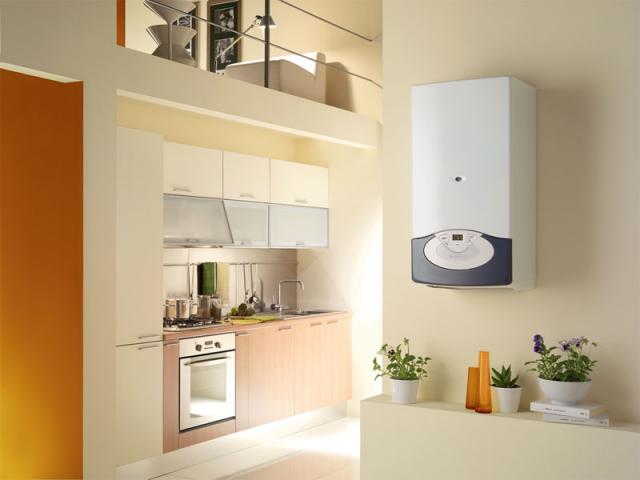

Wall mounted boiler
- Firstly, they are small in size so that they can be installed even in kitchens. Moreover, their appearance does not spoil the interior design at all.
- Secondly, wall-mounted heating boilers are real mini-boiler rooms. Their design includes a circulation pump, an expansion tank, as well as control and safety devices.
- Thirdly, such heating installations can have a capacity of up to 35 kilowatts, which allows them to heat rooms up to 100 square meters.
- Fourthly, modern manufacturers offer both single-circuit and double-circuit boilers for autonomous heating. So you will also be provided with hot water.
And now an important question - how to choose the right boiler? The main thing is to correctly select the unit according to its design features. It should contain all, without exception, the devices that we mentioned - a pump, a tank and so on. In addition, the presence of a chimney is mandatory, which will ensure not only the removal of fuel combustion products in the case of gas boilers, but also the inflow of clean air from the outside. This means that a wall-mounted gas boiler must be with a closed combustion chamber. And the last - full automation, which will not only simplify the operation of the boiler, but also save on fuel.
Of course, there are more connection problems with gas boilers. But electric counterparts in this regard are simpler. Here it is only necessary to lead a branch from the switchboard with the installation of the machine and connect to the water supply system.
What can be difficult?
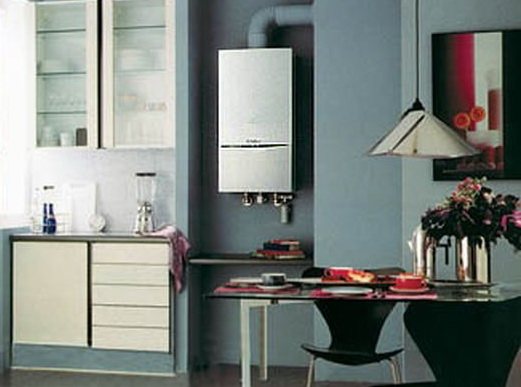

Modern kitchen
It may seem that everything is very simple and beneficial. Then why aren't tenants switching to this heating system? And nobody gives them permission. Imagine that the tenants of one house will immediately apply for the re-equipment of heating networks, or rather, for the refusal of the services of organizations that supply heat to houses. This is, firstly, a disaster for such an organization and the deprivation of its profits. And, secondly, job cuts, although this issue is controversial. Someone also needs to maintain autonomous mini-boiler rooms. So, in many respects, any of these options is not beneficial for management companies. Although on a national scale, the opposite is true. But this issue is not for us to decide.
The main cons
Many potential buyers of gas boilers are scared off by their shortcomings: difficulty in obtaining permits, in installation. There are other factors that can be attributed to the disadvantages, but they can be minimized by making the right choice of model.
- Complexity of installation... We'll have to collect permits for the installation of a gas boiler. The system itself can be assembled on its own, and the connection to the gas system will have to be done with the help of public utilities employees who have all the necessary permits and licenses for this type of activity. Collecting such documentation and organizing the process can be exhausting.
- Water supply breakdown... During these periods, there is no cold water in the house, then heating becomes impossible. While the neighbors with central heating enjoy the warmth, they will have to wait out the technical problem in the cold and without water.
- Additional spending in the old housing stock... Power surges, problems in the water supply system (hard water, etc.) can lead to breakdowns.Protection methods are usually best coordinated with specialists. Depending on the type of problem, you will need to descale more often or install a voltage regulator.
- Noisy work... It all depends on the brand. If the boiler is installed in a non-living room that has good sound insulation, almost any model can be selected. For a one-room apartment, it is better to focus on quality options that have a low noise level.
- The aesthetics of space can be compromised... It is difficult to hide the boiler, while it is impossible to violate the standards. It must be easily accessible in case of breakdown. For owners of small apartments, this can create certain difficulties.
In most cases, the disadvantages of gas boilers are eliminated through an individual approach. With the help of craftsmen and specialists, you can choose a model for every taste and for different tasks. You may have to pay extra for comfort from quiet operation, for aesthetics for particularly compact options. But since the payback of such equipment is a matter of a short period of time, it is sometimes worth adding a little money to avoid common problems with boilers.
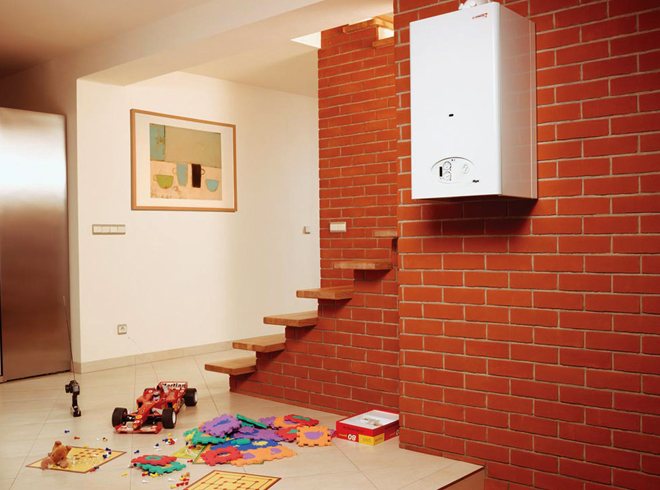

Autonomous heating in an apartment building
Is it possible to install autonomous heating in an apartment with your own hands? Although there is no legal ban on autonomous heating, it is still advisable to consult a lawyer, since some heating systems are prohibited. For example, water-heated floors in apartments cannot be installed due to the fact that they can overload the system, thus depriving other residents of the house of heat.
In other cases, it is required to collect the necessary documents and submit them to local authorities:
- registration certificate for housing;
- a statement of abandonment of central heating;
- title deed;
- a diagram of a new heating system;
- the consent of all tenants of the apartment.
As a rule, such a seemingly simple request, such as giving up central heating and switching to heating itself, turns out to be a long-term bureaucratic problem.
The installation of autonomous heating in the apartment without the appropriate permission will become even more troublesome. This can end not only with a large fine, but also with legal proceedings, so before deciding to equip an apartment with any heating systems, you need to get advice from the relevant authorities and a permit for autonomous heating in the apartment.
Autonomous heating schemes for an apartment:
Advantages and disadvantages
If a permit has already been obtained for autonomous heating in an apartment building, then you can start choosing an alternative type of heat. It is easier to do this knowing the pros and cons of autonomous heating in the apartment.
For the first time, an autonomous heating system for an apartment appeared in Europe. Due to its clear advantages over centralized methods of space heating, it quickly spread throughout the world.
- The main advantage of the system is the significant cost savings. The owner of the apartment independently decides when to turn on and when to turn off the heating. For example, today there are thermostats in which you can set a timer for a specific time, which allows you to either completely or partially turn off the system when there is no one at home, and turn it on half an hour before the arrival of the tenants.
- The owner of the apartment can create the desired microclimate in each room.
- Pay exclusively for the heating meter and not depend on utilities and government tariffs.
When making a choice in favor of alternative heat, you need to know in advance how much autonomous heating costs in an apartment, and what kind of heating it will be not only economical, but also effective.
Among the disadvantages of such a system, the following nuances can be noted:
- Its regular preventive check once a year, for which you need to call a specialist. It's not that expensive, but still, many users either ignore this need, or simply forget about it.
- Installing even the best heating radiators for an apartment. you should be aware of possible heat loss. which are often caused by external walls, unheated from the bottom of the room or poor quality glazing.
Today, many construction organizations are building residential apartment buildings with ready-made autonomous heating systems. Such housing is in great demand, as it costs a little less and allows the owners to independently decide which type of heating to choose.


